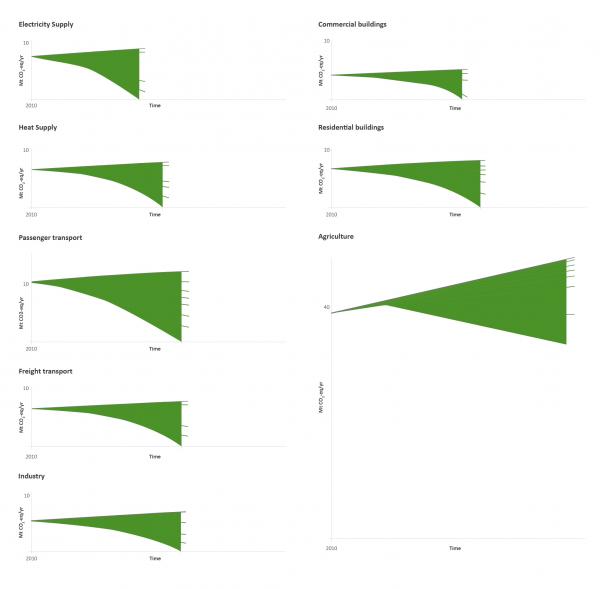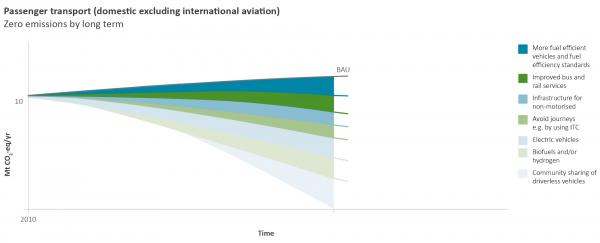Emission reduction pathways
This section outlines some potential ways sectors can head towards zero emissions. Evidence for mitigation pathways for New Zealand is deficient so these figures are just to provide an indicative approach only.
Investment in data gathering and deeper analysis will help refine early mitigation actions and support a transparent public debate about longer term desirable and feasible mitigation pathways.

An approximation of potential emission reductions by NZ economy sectors over time
These figures are an approximation based on expert opinion and simply serves to illustrate that all sectors can contribute to GHG emission reductions in New Zealand; achieving zero emissions will be more rapid in some sectors than others with the decarbonising of the electricity sector likely to happen first; and that achieving zero emissions for New Zealand’s agricultural sector is unlikely this century unless there are trade-offs with current growth targets for livestock production and the development of alternative low GHG emitting landuses. However, for the current farming systems, there is some potential for total agricultural emissions to be reduced over time compared with business-as-usual.
Potential actions that New Zealand could take from the range of mitigation opportunities that exist in all sectors, are outlined in more detail below. They are also based on expert opinion, are approximations only, and purely indicative given the high uncertainties of factors such as future costs, trade-offs, technology deployment rates, policies and the absence of detailed data and analysis. Some mitigation options are ready for immediate deployment, while others will not come on stream until various times in the future.
Individual sectors






Key findings
- A transition to a low-carbon economy is possible over the next few decades if we start now and include coherent aspirations and actions across agencies and businesses as well as by communities and individuals.
- If New Zealand wishes to take domestic actions to significantly reduce our current GHG emissions, households, cities, commercial enterprises and land-users will all need to make changes in order to reduce their GHG emissions significantly.
- Although there have been some useful studies of future mitigation pathways for New Zealand, information to enable quantitative and realistic pathways to be produced is scarce and there is a lack of detailed data to enable further analysis to be undertaken to fill the knowledge gaps.
- The term ‘pathways’ suggests that there are a number of different ways to proceed towards approaching net zero emissions around the second half of the century. However, all routes that might achieve this goal include implementing all feasible means of avoiding activities, products and services that involve releasing CO2 from the burning of fossil fuels.
- Models developed for emission reduction pathways elsewhere could be adapted for use by New Zealand assessments, given time and resources.
- Judgements based on current knowledge of innovative technology development and assumptions on future costs, deployment rates, and carbon prices, can be used to provide at least an indication of future mitigation trajectories in each sector.
- All sectors have good potential to reduce emissions and gain the many co-benefits including cost savings, although for some sectors, the mitigation costs in terms of $/t CO2-eq avoided, are unknown.
- To support immediate and short-term mitigation actions, especially those relating to behavioural changes by households and businesses, an effective carbon pricing regime would increase the rate of mitigation.
- The more uncertain or politically difficult GHG reductions, such as agricultural emissions, can evolve over the longer term.
Read the summary
- What can we do to reduce emissions, and in what order? p10
Read the report
Emission reduction pathways p162
- Review of approaches to producing mitigation pathways
- Mitigation pathways for New Zealand
